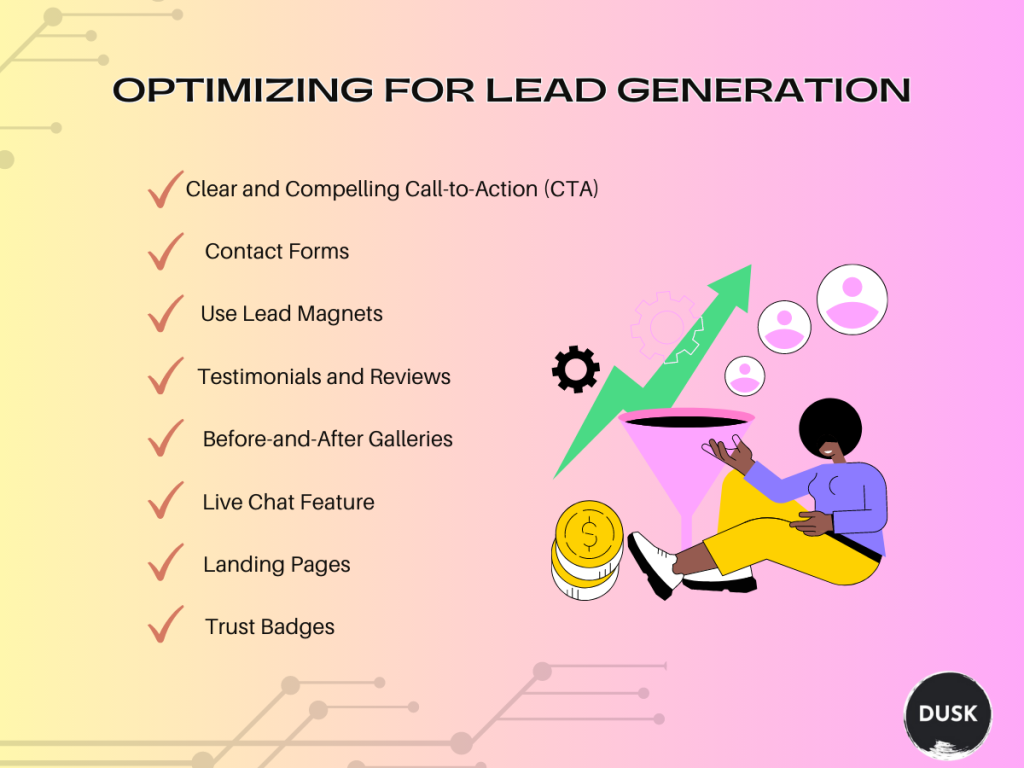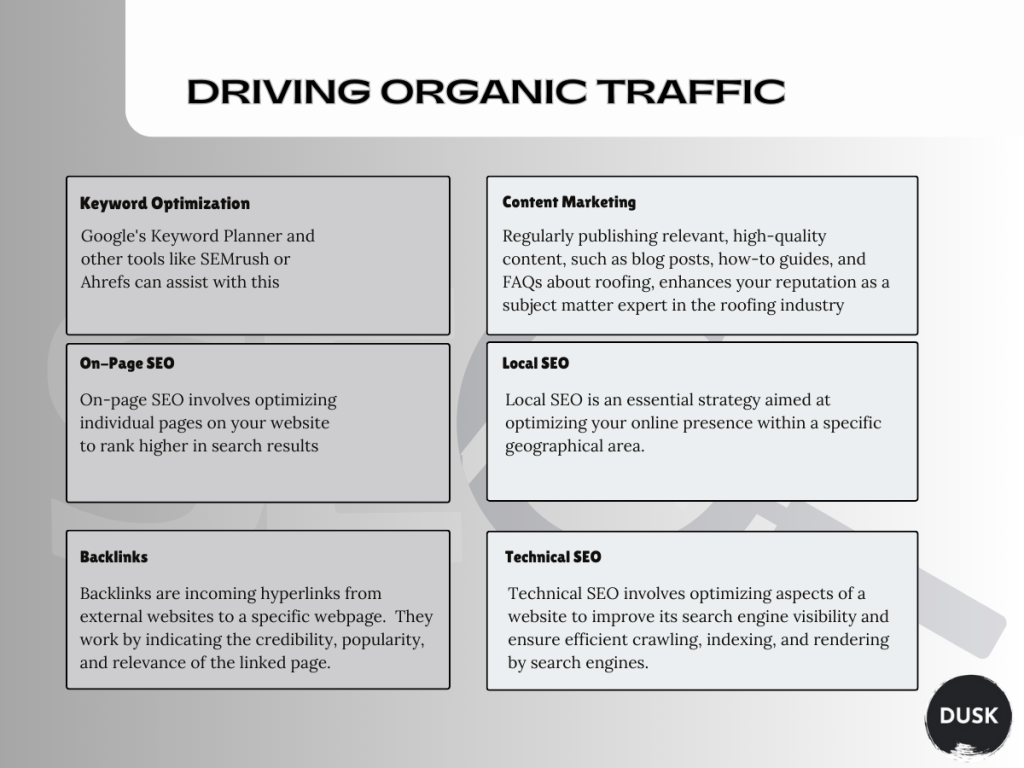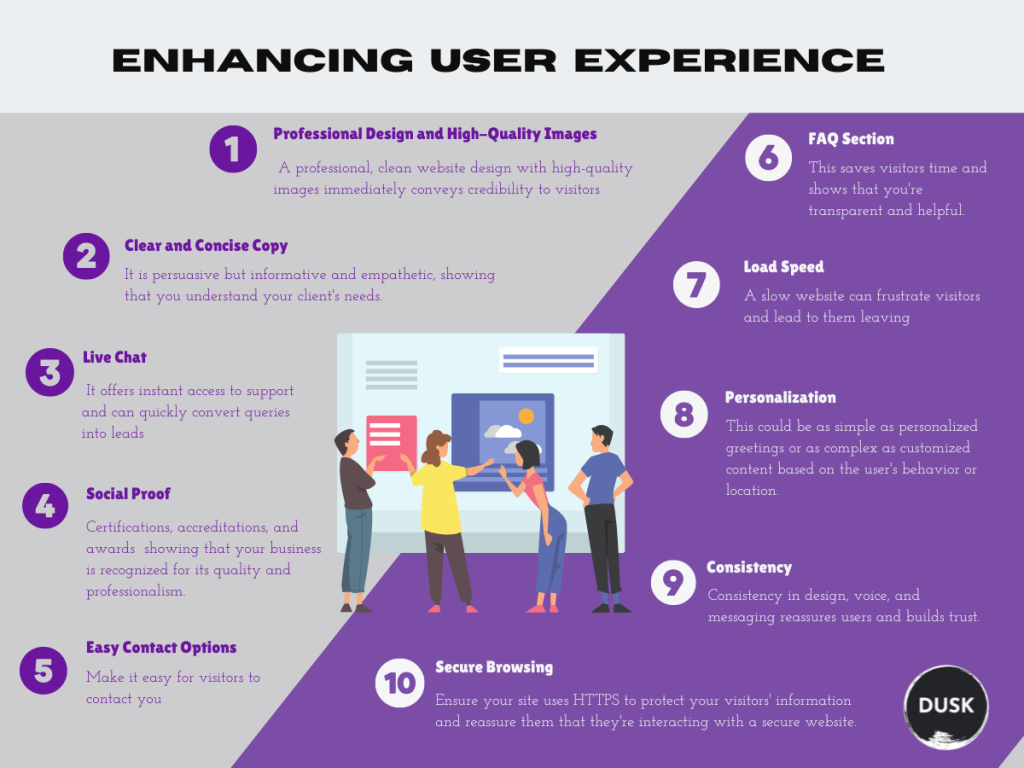In the competitive landscape of the roofing industry, creating an effective online presence can be a game-changer.What are the best tips to optimize your roofing company’s website? A well-optimized website serves as the digital front door of your roofing company, attracting potential customers and showcasing your expertise and credibility.
However, it’s not just about having a website, and it’s about having a website that works for you – driving organic traffic, generating qualified leads, and providing a user experience that turns visitors into loyal customers. This comprehensive guide will walk you through how to optimize your roofing company’s website for conversions, enhance user experience, and boost your digital marketing efforts.
Let’s begin!
Building A Strong Foundation: User-Friendly Website Design
Creating a user-friendly website is foundational to optimizing your roofing company’s website. It involves making the site accessible, easy to use, and enjoyable for your users while effectively communicating your brand and services. Here are key aspects you should consider:
Choosing the Right Platform
Your website platform is like your site’s blueprint. It should be easy to use and customizable. Popular platforms include WordPress, Wix, Squarespace, and Shopify. WordPress, for instance, is known for its versatility and vast selection of themes and plugins. Make sure to choose a platform that aligns with your needs and capabilities.
Responsive Design
A responsive design ensures that your website adapts to the screen size of the device it’s being viewed on. Given that a large proportion of web traffic comes from mobile devices, it’s critical that your site looks good and functions smoothly on smaller screens. Responsive design also improves your SEO since Google gives preference to mobile-friendly websites.
Intuitive Navigation
Your website’s navigation should be simple and intuitive. Users should be able to find what they’re looking for without frustration. Make sure your services, contact information, and about page are easy to find on the homepage. Use clear menu categories and avoid too many sub-menus. A site map can also enhance navigation, especially for larger websites.
Site Speed
The speed at which your website loads is crucial for retaining visitors and improving SEO. Slow load times can frustrate visitors and may lead to higher bounce rates. Several factors can slow down your sites, such as large image files, excess scripts, or poor hosting service.
Consider optimizing your images, implementing lazy loading (where content only loads when it’s about to come into view), and using a reliable, high-speed hosting service to ensure your site loads as quickly as possible.
Readability and Design Aesthetics
Your website should be visually pleasing, with a consistent color scheme and typography that aligns with your branding. Keep your design clean and uncluttered, and make sure your text is easily readable. Break up large blocks of text with images, bullet points, or subheadings.
Accessibility
Your website should be accessible to everyone, including those with disabilities. This means considering factors like color contrast and font size and providing text alternatives for non-text content. Incorporating these features broadens your potential audience and can improve your site’s SEO.
Overall, a strong, user-friendly website design is not just about looks – it encompasses performance, navigability, and accessibility. It’s the foundation upon which you can build an effective, conversion-optimized website for your roofing business.
Increasing Conversions: Optimizing for Lead Generation
As a roofing company, one of your key online goals is likely to generate more leads. That means your website shouldn’t just be a digital brochure but a lead generation machine. Here are several strategies to optimize your website for more conversions:

1. Clear and Compelling Call-to-Action (CTA)
Every page on your website should have a clear goal and encourage users to take a specific action. This could be scheduling a free consultation, requesting a quote, or downloading a helpful guide on roof maintenance. Use compelling language in your CTAs and make sure they stand out visually.
2. Contact Forms
Your contact forms are crucial for lead generation. They should be easy to find, simple to fill out, and only ask for the necessary information to reduce friction. It’s also important to ensure they are mobile-friendly. Embedding these forms on multiple pages, including specific service pages and your homepage, enhances conversions.
3. Use Lead Magnets
A lead magnet is a free item or service given away for the purpose of gathering contact details. For a roofing company, this could be an e-book on “How to Maintain Your Roof and Extend its Life,” a discount coupon for first-time customers, or a free consultation or estimate.
4. Testimonials and Reviews
Positive reviews and testimonials from past customers can be incredibly convincing. Consider dedicating a section of your site to showcase or scatter these testimonials throughout your site for increased credibility. They serve as social proof and can persuade potential customers to choose your company over competitors.
5. Before-and-After Galleries
Before-and-after photos are another form of social proof, demonstrating the quality and impact of your work. These galleries can be particularly effective in the roofing industry, where transformations can be dramatic.
6. Live Chat Feature
A live chat feature allows visitors to get immediate answers to their questions, which can dramatically increase conversions. If staffing this live chat around the clock isn’t feasible, consider using a chatbot to handle after-hours inquiries or frequently asked questions.
7. Trust Badges
Trust badges are symbols from third parties vouching for your security or competence. This could be Better Business Bureau accreditation, industry awards, or secure payment badges. Display these prominently to reassure visitors of your credibility.
8. Landing Pages
For specific campaigns, creating dedicated landing pages can help improve conversions. These pages should be focused on a single action you want the visitor to take and designed to limit distractions. Moreover, these landing pages allow you to track and measure the success of your campaigns effectively, providing valuable insights to refine your marketing strategies further.
Driving Organic Traffic: SEO Best Practices
Search engine optimization (SEO) is critical for driving organic traffic to your website. By optimizing your website for SEO, you increase its visibility in search engine results, leading to more potential customers discovering your roofing services.
Below are some essential SEO practices for your roofing company’s website:

Keyword Optimization
Start by conducting comprehensive keyword research to identify the terms potential customers use when searching for roofing services. Google’s Keyword Planner and other tools like SEMrush or Ahrefs can assist with this. Remember to include both general terms like “roof repair” and location-specific terms like “roofing services in Denver” to capture local traffic.
Once you’ve identified your keywords, incorporate them strategically throughout your website— in your content, headers, meta descriptions, URLs, and image alt tags. Avoid keyword stuffing, though, as search engines can penalize this.
On-Page SEO
On-page SEO involves optimizing individual pages on your website to rank higher in search results. Key elements to consider include:
- Meta Titles and Descriptions: The title and summaries that appear in search engine results. They should be compelling and include your target keywords.
- Headers: Use H1, H2, and H3 tags to organize your content and make it easy to read. Your main keyword should be in your H1 tag.
- URL Structure: URLs should be short, readable, and include your target keyword.
- Image Alt Text: This is the text that displays if an image can’t load and helps search engines understand the image’s content. Include your keywords where relevant.
Local SEO
As a roofing company, you’re most likely serving a specific geographic area. To rank in local search results:
- Claim Your Google My Business Listing: This helps you appear in local search results and on Google Maps. Ensure your information is accurate and complete.
- Consistent NAP Information: Ensure your Name, Address, and Phone number are consistent across all platforms, including your website, social media, and online directories.
- Collect Reviews: Encourage happy customers to leave reviews on Google to improve your local reputation and ranking.
Content Marketing
Regularly publishing relevant, high-quality content, such as blog posts, how-to guides, and FAQs about roofing, enhances your reputation as a subject matter expert in the roofing industry. This expertise, manifested through valuable content, increases your website’s visibility to search engines, thus boosting organic traffic.
This can build trust, show your company’s deep understanding of the industry and client needs, and portray your business as the go-to solution for their roofing concerns. Therefore, maintaining an active content schedule is not just an SEO strategy—it’s a comprehensive approach to marketing and customer service.
Technical SEO
Ensuring that your website is technically sound is critical to optimizing your roofing company’s website. Key elements include:
- A responsive design that adapts to various screen sizes and devices.
- Quick load times to prevent user drop-off.
- A secure connection (HTTPS) to protect user data.
- A sitemap to guide search engines when crawling and indexing your site.
Technical issues, if any, can drastically affect your website’s performance, user experience and, by extension, your search engine ranking. Consider utilizing an SEO audit tool or consulting an SEO expert to diagnose and rectify these issues.
Regular audits can reveal hidden technical problems, providing insights and recommendations to optimize your website, enhance user experience, and improve your online presence. The ultimate goal is to build a technically sound and user-friendly website that both search engines and users love.
Backlinks
Backlinks, links from other websites to yours, are a major ranking factor for search engines. Acquire backlinks by creating shareable content, partnering with relevant local businesses, and listing your site in trusted directories.
Remember, SEO is a long-term strategy. It requires ongoing effort and adaptability as search engine algorithms evolve. By implementing these SEO best practices, you can improve your website’s ranking, drive more organic traffic, and increase the chances of converting that traffic into leads and customers.
Enhancing User Experience: Building Trust and Engagement
Creating an engaging, trustworthy online presence is crucial for any business, including your roofing company. Here’s how to enhance the user experience and build trust on your website:

- Professional Design and High-Quality Images
First impressions matter. A professional, clean website design with high-quality images immediately conveys credibility to visitors. Use images of your team, your past projects, and any other relevant visuals that can help potential clients understand the quality of your work.
- Clear and Concise Copy
Avoid industry jargon and write for your audience. Your website content should be easy to understand and focus on how your services can solve the customer’s problems. Good copy is persuasive but informative and empathetic, showing that you understand your client’s needs.
- Live Chat
Having a live chat feature can enhance user experience significantly. It offers instant access to support and can quickly convert queries into leads. If it’s not feasible to have someone available at all times, consider using a chatbot for basic questions.
- Social Proof
In addition to testimonials and reviews, display other forms of social proof, such as the number of jobs completed or clients served. Certifications, accreditations, and awards also contribute to this proof, showing that your business is recognized for its quality and professionalism.
- Easy Contact Options
Make it easy for visitors to contact you. Display your phone number prominently, provide a simple contact form, and consider adding options like live chat or a callback service.
- FAQ Section
An FAQ section can improve user experience by providing instant answers to common questions about your roofing services, processes, warranties, and more. This saves visitors time and shows that you’re transparent and helpful.
- Load Speed
Site speed is a key element of user experience. A slow website can frustrate visitors and lead to them leaving. Optimize your images, use caching, and minimize the use of unnecessary scripts to enhance your website’s load speed.
- Personalization
Where possible, offer personalized experiences. This could be as simple as personalized greetings or as complex as customized content based on the user’s behavior or location.
- Consistency
Consistency in design, voice, and messaging reassures users and builds trust. This means maintaining the same color schemes, fonts, and tone across all pages.
- Secure Browsing
With increasing data privacy concerns, secure browsing is essential. Ensure your site uses HTTPS to protect your visitors’ information and reassure them that they’re interacting with a secure website.
A user-friendly website attracts potential clients, builds trust, encourages engagement, and improves conversions. Keep user experience at the forefront of your website optimization strategies because a happy visitor is more likely to become a loyal customer.
There You Have It!
Optimizing your roofing company’s website for conversions and user experience is a multifaceted process that requires strategic planning, technical expertise, and a user-focused approach.
Remember, while it might seem challenging, the rewards of optimizing your website are significant. With patience, consistency, and a deep understanding of your audience’s needs, your roofing company can create a robust online presence that positions you as a trusted industry leader and helps your business reach new heights.






